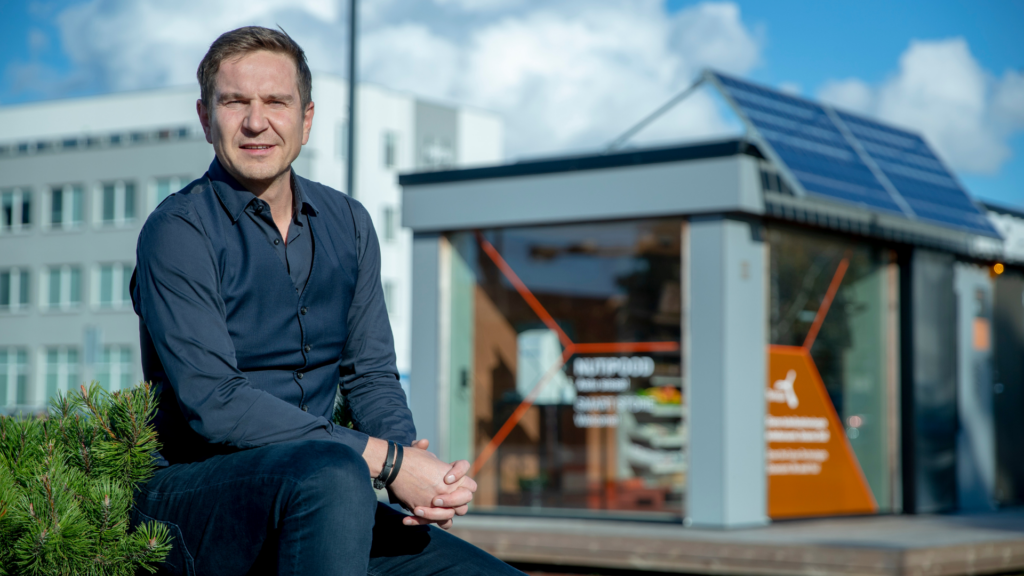13.07.2021
Ragmar Saksing: blueberries trump pine logs or how to find balance in the green economy

To find new economic models, the question, “but how has nature solved this problem?” is helpful, writes Ragmar Saksing, Head of Green Technology at Tehnopol Science and Business Park.
It’s been clear for a relatively long time that current economic and business models are not sustainable from an environmental perspective. Nature has posed a challenge to business, which requires one to break free of existing thought patterns. Entrepreneurs need to look for new ways to do business responsibly.
There are two directions in the green economy – the old economy and the new economy. The old economy plans to adapt, it wants to make a green turn. This is an economy that began with a major industrial revolution.
Some have said the Industrial Revolution began in 1908, when a company led by Henry Ford in America began production of the Ford model T automobile. Since then, the burning of fossil fuels worldwide has led to an exponential increase in carbon emissions into the atmosphere. In practice, however, this means getting rich at the expense of the environment. If we draw something from the earth’s crust to set it on fire, the atmosphere and the seas will be full of it. There will be a void in the ground and substances that shouldn’t be in the sea will end up there.
The new economy is based on balance. The corners of the equilibrium triangle are the economy, the environment, and society. If one of them gets over emphasized, the balance is lost and the system collapses. Let us also note that a system with too much or no emphasis on the environment will not survive either. The economy is important, but not essential. The whole is always greater than the sum of the parts.
“I believe that …” doesn’t count here. If we agree and use the laws of nature as the basis for the functioning of the world, we will think for a moment about how nature has solved the question of balance. Imagine a chicken that focuses only on laying eggs and doesn’t pay attention to raising chicks. Or imagine a tree that focuses only on chlorophyll production but neglects to prevent water evaporation. Of course, it is not necessary to be a biologist to realize that focusing on a single outcome is not only detrimental to the system, but also undermines long-term survival.
Nature understandably doesn’t care what our influential people think, what they believe or do not believe. Nature lives, acts, reacts, fights, suffers, recovers.
Natural systems work differently, are based on diversity and depend mainly on local flows of substances, nutrients, and energy. At the same time, it is ensured that everything necessary can be obtained from several sources. It creates a system that allows many basic needs to be met with local resources, within the limits of carrying capacity and replacing the unnecessary (and toxic) and creating more value from what exists. The new economy follows similar principles, drawing inspiration from the considerable capacity of ecosystems to create something from seemingly nothing. The old man-made economic systems do not work that way. The focus is usually on only one parameter – profit.
To understand that this can in no way be sustainable, I ask some unanswered questions:
- Why are producers in Asia not dealing with waste here in Europe or vice versa?
- Why is the burning of mineral resources to produce heat and electricity still supported by public funding?
- Why does the old economy always have to be the lowest cost?
- Why are human economic activities and/or the desire to make a profit still the cause of species extinction?
These are understandably complex questions and we cannot find a single answer here. However, I think the main reason stems from old economic models, ignorance, and the spread of half-truths. An influential person’s phrase “I believe …” doesn’t count here. The facts matter. If we consider nature to be superior, then nature understandably doesn’t care what our influential people think, what they believe or do not believe. Nature lives, acts, reacts, fights, suffers, recovers.
An Estonian forest example
Man-made environmental problems are complex. I like to compare them to cooked spaghetti. Of course, we would like the problems to be easy to compartmentalize and, figuratively speaking, to be lifted from one pile to another – like a pack of uncooked spaghetti. Unfortunately, this is not the case. These spaghetti are cooked through, mixed, and contain various sauces, spices. If we pull from one end, we never know exactly what is happening on the other end. Nature does not turn over the soil like a human being does. In nature, earthworms, insects, fungi, bacteria stimulate and disturb the soil.
I will provide an example of this complexity: the Estonian forest. A forest is a complete organism, with an order of a thousand other species associated with each tree species. A forest is treated as a resource and its value is measured in logs. At the same time, it is generally known that the composition of clear-cut forest soil changes, UV radiation reaches the ground, and the plants that were characteristic of the area no longer grow there.
Nature does not turn over the soil like a human being. In nature, earthworms, insects, fungi, bacteria stimulate and disturb the soil. But if the structure of the soil has changed and these changes no longer exist, the forest will not recover in this way. The natural richness of the cleared forest is restored at a maximum speed of 100 meters per year. It’s a kilometer of forest in 10 years, 10 kilometers of forest in 100 years, and so on.
I am not saying that the forest must not be cut down. Of course you can and must. But not in a way that is not in line with producing offspring.
Blueberries trump pine logs
Let’s do one calculation that illustrates a bit the principles of the new economy. Let’s compare the price of pine logs and blueberries. I based my calculations on average orders of magnitude, and did not take into account the cost of picking blueberries, cutting pine logs, or the growing times of both. This calculation does not claim to be the ultimate truth, but it perfectly illustrates what has been said.
As a result of the calculation made for the paper corner, I found that in the worst case, when selling blueberries and logs at wholesale prices, the difference is €500 versus €225 per hectare per year in favor of blueberries. At best, when it comes to selling blueberries and logs, the difference is €2,600 versus €320 a year per hectare in favor of blueberries. We should declare blueberries the winner and start planning new economic and business models, where we pick blueberries, get moderate logs, and grow the forest in a way typical of the place!
Nature’s perfect engineers
The question: “But how has nature solved this problem?” helps to find new economic models. From this question, in fact, arises the whole branch of science called biomimicry (bios – life; and mimesis – imitation). This new discipline seeks the best design ideas in nature and tries to solve human problems by imitating them. 70,000 years of human history is understandably too little an experience to think, “That’s what we’ve been doing all along.”
The basic idea of biomimicry is that nature has millions of years of experience and has already solved many of the problems we are currently facing. Insects, animals, plants, and microbes are perfect engineers because they have found solutions for themselves that work on our planet, that fit here and, most importantly, that can withstand pressure. There are examples in industrial design, architecture, medicine, transport as well as in dealing with environmental toxins.
In our green technology team at Tehnopol, we know that there are already business opportunities that generate revenue properly and that will improve the environment and society! That’s why we also offer a test environment for such companies in our campus to test their own solutions. We know that business can be done in such a way that waste is not stored and no one suffers from scarcity. Nature has done this for 3.8 billion years, 70,000 years of human history is understandably too little to think, “That’s what we’ve been doing all along.”
You could start, for example, by analyzing the supply chain in your field. How does the factory where we buy our raw materials work, are they balanced? If not, look for an alternative. And there must be no obstacle here that production will become more expensive as a result. This means being honest with the business environment, because inequalities in the green economy will end sooner or later. Later, it will be just several times more expensive.












